
Janssen is an ancient impact crater located in the highland region near the southeastern lunar limb. The entire structure has been heavily worn and is marked by many lesser crater impacts. The outer wall is breached in multiple locations, but the outline of the crater rim can still be observed. The wall forms a distinctive hexagonal shape upon the rugged lunar surface, with a slight curvature at the vertices.

Dawes is a lunar impact crater located in the wide straight between Mare Serenitatis and Mare Tranquilitatis. To its southwest lies the larger crater Plinius, and to its northeast sits the Mons Argaeus mountain rise. It is named after British astronomer William Rutter Dawes.

Abul Wafa is an impact crater located near the lunar equator on the far side of the Moon, named after the Persian mathematician and astronomer Abu al-Wafa' Buzjani. To the east are the crater pair Ctesibius and Heron. In the northeast lies the larger crater King, and to the southwest is Vesalius.
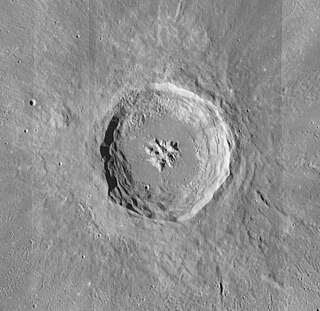
Aristillus is a prominent lunar impact crater that lies in the eastern Mare Imbrium. It was named after Greek astronomer Aristyllus. Directly to the south is the smaller crater Autolycus, while to the southwest is the large Archimedes. To the northeast are the craters Theaetetus and Cassini.

Abenezra is a lunar impact crater located in the rugged highlands in the south-central section of the Moon. Abenezra is named after the Sephardic Jewish sage, poet, biblical commentator, astronomer, and astrologer Abraham ibn Ezra. It is attached along the southeast rim to the crater Azophi. To the northeast lies the crater Geber, and further to the southeast is the larger Sacrobosco.

Bianchini is a lunar impact crater that lies along the northern Jura Mountains that ring the Sinus Iridum, in the northwestern part of the near side of the Moon. It was named after Italian astronomer Francesco Bianchini. The impact of this crater near the edge of the Jura Mountains deposited some material into the Sinus Iridum floor.
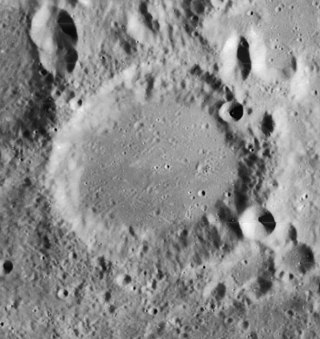
Apianus is a lunar impact crater that is located on the rugged south-central highlands of the Moon. It is named after 16th century German mathematician and astronomer Petrus Apianus. It is located to the northeast of the crater Aliacensis, and to the northwest of Poisson. The worn crater Krusenstern is attached to the west-northwestern rim.

Donati is a lunar impact crater that is located in the rugged south-central highlands of the Moon. It lies just to the northwest of the crater Faye, and the two outer rims are separated by a gap of less than 10 kilometers. To the north is the comparably sized Airy, and farther to the southeast is Playfair. Donati is 36 kilometers in diameter.

Beals is a lunar impact crater that is located near the eastern limb of the Moon, and lies across the southwestern rim of the crater Riemann. From the Earth the crater is viewed nearly from on edge, and is best seen during favorable librations. To the west is the large walled plain Gauss.

Biela is a lunar impact crater that is located in the rugged highlands of the southeastern Moon. It is named after Austrian astronomer Wilhelm von Biela. The crater lies to the east of Rosenberger, to the southeast of the Watt–Steinheil double crater.
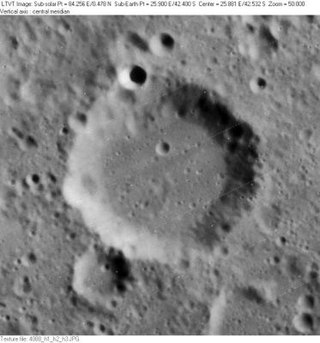
Nicolai is a lunar impact crater that is located in the southern hemisphere of the Moon, in a region that is less disturbed by significant impacts than most of the highlands. The nearest craters of note are Spallanzani to the south, and the much larger Maurolycus and Barocius to the east. The crater is named after the 19th-century German astronomer Friedrich Bernhard Gottfried Nicolai. It is 42 kilometers in diameter and reaches a depth of 1.8 kilometers.
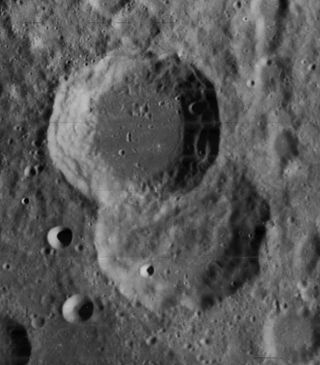
Watt is a lunar impact crater that is located in the southeastern part of the Moon. It was named after Scottish inventor James Watt. The northwestern third of the crater rim has been completely overlain by the same-sized Steinheil, leaving much of the interior floor covered with the outer rampart of ejecta from the latter formation. The remainder of the rim of Watt is somewhat jagged in appearance, with an inward bulge along the southeast rim and a pair of small outward projections to the northeast. The rim is otherwise relatively sharply defined, with only a minor amount of wear.

Banachiewicz is a largely degraded lunar impact crater that is located near the eastern limb of the Moon.

Chapman is a lunar impact crater that lies just beyond the northwest rim of the Moon, on the far side as seen from the Earth. It lies to the northeast of the crater Rynin, and southward of the large walled plain Poczobutt.

Dyson is a lunar impact crater, 63 kilometers in diameter, that lies on the far side of the Moon, past the northwest limb. It is located in the northern part of the surface, to the northwest of the crater Coulomb, and east of van't Hoff.

Nearch is a lunar impact crater that is located in the southeastern part of the Moon, to the southeast of the crater Hommel. North of Nearch is Vlacq, and to the northeast lies Rosenberger. The crater is 76 kilometers in diameter and 2.9 kilometers deep. It is from the Pre-Nectarian period, 4.55 to 3.92 billion years ago.
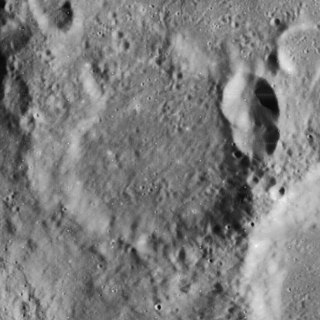
Krusenstern is a lunar impact crater that lies amidst the battered terrain in the southern part of the Moon's near side. Nearly attached to the east-southeast rim is the crater Apianus. Less than one crater diameter to the southwest is the prominent Werner. Krusenstern is intruding into a large circular plain to the north designated Playfair G. Playfair itself lies to the northeast.

Pontanus is a lunar impact crater that is located in the southern highlands of the Moon's near side. It lies approximately midway between the craters Sacrobosco to the north-northeast and Gemma Frisius to the south-southwest. It is 58 kilometers in diameter and 2,120 meters deep.

Kinau is a small, eroded lunar impact crater that is located in the low southern latitudes of the Moon. It lies to the southeast of the crater Jacobi, and about equally far to the north-northwest of Pentland. It is 42 kilometers in diameter and two kilometers deep. It may be from the Pre-Nectarian period, 4.55 to 3.85 billion years ago.

Seyfert is a prominent lunar impact crater that is located on the far side of the Moon. It was named after American astronomer Carl Keenan Seyfert. It lies behind the eastern limb of the Moon, to the east of the crater Espin. Just to the north of Seyfert is the crater Harriot and equally close to the south is Polzunov.




















